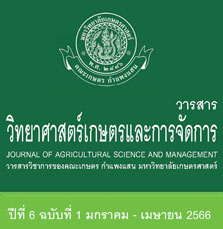ผลของปริมาณการให้น้ำต่อผลผลิต ปริมาณแคปไซซิน และผลผลิตแคปไซซินในพริกกะเหรี่ยงพันธุ์กำแพงแสน สกว 135
คำสำคัญ:
การจำกัดการให้น้ำ, ผลผลิต , ผลผลิตแคปไซซิน, Capsicum frutescensบทคัดย่อ
ปริมาณน้ำที่พืชได้รับส่งผลกระทบต่อต้นพืชได้หลายประการ การศึกษานี้มีวัตถุประสงค์เพื่อเปรียบเทียบผลของระดับการให้น้ำในช่วงการติดดอกถึงการพัฒนาของผลที่แตกต่างกัน 4 ระดับ ได้แก่ 100 (ควบคุม) 80 60 และ 40% MWHC (maximum water holding capacity) ต่อผลผลิต ปริมาณสารแคปไซซิน และผลผลิตแคปไซซินของพริกกะเหรี่ยงพันธุ์กำแพงแสน สกว 135 โดยพบว่า การลดระดับการให้น้ำทำให้ศักย์ของน้ำในใบพริก ณ เที่ยงวัน (LWPmd) ลดลงอย่างมีนัยสำคัญทางสถิติเมื่อเปรียบเทียบกับชุดควบคุม โดยพบการลดลงที่ 2 สัปดาห์หลังการจำกัดการให้น้ำสำหรับการให้น้ำที่ระดับ 80% MWHC ในขณะที่การให้น้ำที่ระดับ 40 และ 60% MWHC พบการลดลงของ LWPmd ในสัปดาห์แรกหลังการจำกัดการให้น้ำ การให้น้ำที่ระดับ 80% MWHC ให้ผลผลิตและปริมาณแคปไซซินไม่แตกต่างกันกับชุดควบคุม ในขณะที่การให้น้ำในระดับที่ระดับ 40 และ 60% MWHC ทำให้ผลผลิตพริกลดลง หากสามารถเพิ่มปริมาณแคปไซซินได้ถึง 181.73 และ 116.65% ตามลำดับ เมื่อเปรียบเทียบกับชุดควบคุม อย่างไรก็ตามระดับการให้น้ำที่ศึกษาไม่ทำให้ผลผลิตแคปไซซินที่ได้รับแตกต่างกันอย่างมีนัยสำคัญทางสถิติ
เอกสารอ้างอิง
จริยา วิสิทธิ์พานิช เกวลิน คุณาศักดากุล อิทธิสุนทร นันทกิจ วนิดา ดวงก้งแสน กรุง สีตะธนี สิริกุล วะสี อัญชัน ชมพูพวงและ ประนอม ใจอ้าย. 2554. พัฒนาระบบการปลูกพริกพิโรธเชิงการค้าในสภาพแวดล้อมที่แตกต่างกัน. สำนักงานกองทุนสนับสนุนงานวิจัย, กรุงเทพฯ. 260 หน้า.
เจนจิรา แก้วมาลัย ขนิษฐา กำคำมูล และกรุง สีตะธนี. 2556. การพัฒนาพันธุ์พริกสารเผ็ดสูงเชิงการค้า. หน้า 191-197. ใน: การประชุมทางวิชาการของมหาวิทยาลัยเกษตรศาสตร์ ครั้งที่ 51: สาขาพืช. มหาวิทยาลัยเกษตรศาสตร์, กรุงเทพฯ.
ตวงสิทธิ์ ยะนิล นิรันดร์ พลธี กฤดา ชูเกียรติศิริ และจุฬากร ปานะถึก. 2559. การเสริมพริกป่น (Capsicum frutescens Linn.) ในอาหารต่อสมรรถนะในการให้ผลผลิตและคุณภาพซากของไก่พื้นเมืองพันธุ์ประดู่หางดำ. แก่นเกษตร 44(1) (พิเศษ): 459-464.
ธรรมศักดิ์ ทองเกตุ. 2559. อิทธิพลของธาตุอาหารหลักเพื่อควบคุมความเผ็ดในพริก.(ออนไลน์). แหล่งข้อมูล https://www3.rdi.ku.ac.th/?p=28737 (25 กันยายน 2565).
นันทิยา ฤทธิ์เดช. 2561. มารู้จักกับตัวยา “แคปไซซิน” บรรเทาอาการปวดเมื่อย. (ออนไลน์). แหล่งข้อมูล https://www.rama.mahidol.ac.th/ramachannel/infographic/มารู้จักกับตัวยา-แคปไซ/ (25 กันยายน 2565).
วิโรจน์ ภัทรจินดา. 2556. แนวทางการใช้สมุนไพรในปศุสัตว์ประเทศไทย. แก่นเกษตร 41(4): 377-382.
วีรศิลป์ สอนจรูญ สุมน มาสุธน พรพรรณ พรศิลปทิพย์ และเสาวณี สาธรวิริยะพงศ์. 2555. กายวิภาคศาสตร์เปรียบเทียบของใบและปริมาณแคปไซซินของพริกขี้หนูสวนและพริกกะเหรี่ยง (Capsicum frutescens L.). วารสารพฤกษศาสตร์ไทย 4 (ฉบับพิเศษ): 57-67.
ศูนย์วิจัยและพัฒนาพืชผักเขตร้อน. 2556. คู่มือการปลูกพริก. มหาวิทยาลัยเกษตรศาสตร์ วิทยาเขตกำแพงแสน, นครปฐม. 19 หน้า.
ศูนย์วิจัยและพัฒนาพืชผักเขตร้อน. 2562. พริกกะเหรี่ยง กำแพงแสน. (ออนไลน์). แหล่งข้อมูล https://www.facebook.com/profile.php?id=100008595977953 (29 มิถุนายน 2563).
สถาพร เงินหลาบ สังคม เตชะวงค์เสถียร และสุชีลา เตชะวงค์เสถียร. 2551. อิทธิพลของไนโตรเจน และโพแทสเซียมต่อผลผลิต และปริมาณสารแคปไซซินในพริก. วารสารวิทยาศาสตร์เกษตร 39(3) (พิเศษ): 305-308.
อรรัตน์ มงคลพร. 2561. การคัดเลือกและพัฒนาพันธุ์พริกกะเหรี่ยงสำหรับเขตภาคกลาง. (ออนไลน์). แหล่งข้อมูล https://tarr.arda.or.th/preview/item/-JW-lW14xUmzBfaGD-jyp (25 กันยายน 2565).
Arom, P. and W. Jinagool. 2021. Water deficit and its impacts on physiological traits, growth, and yield of chili (Capsicum frutescens L.). pp. 477-483. In: Proceeding of SUT International Virtual Conference on Science and Technology (SUT-IVCST 2021), Nakhon Ratchasima.
Balbaa, S. I., M. S. Karawya and A.N. Girgis. 1968. The capsaicin content of Capsicum fruits at different stages of maturity. Loloydia 31(3): 272-274.
Borrell, A. K., G. L. Hammer and R.G. Henzell. 2000. Does maintaining green leaf area in sorghum improve yield under drought? II. dry matter production and yield. Crop Science. 40: 1,037-1,048.
Brouwer, C. and M. Heibloem.1986. Irrigation water management: Irrigation water needs. (Online). Available Source: https://www.fao.org/3/s2022e/s2022e08.htm (October 1, 2022).
Cisneros-Pineda, O., L. W. Torres-Tapia, L. C. Gutierrez-Pacheco, F. Contreras-Martın, T. Gonzalez-Estrada and S. R. PerazaSanchez. 2007. Capsaicinoids quantification in chili peppers cultivated in the state of Yucatan, Mexico. Food Chemistry 104: 1,755-1,760.
Chanthai, S., J. Juangsamoot, C. Ruangviriyachai and S. Techawongstien. 2012. Determination of capsaicin and dihydrocapsaicin in some chilli varieties using accelerated solvent extraction associated with solid-phase extraction methods and RP-HPLC-fluorescence. Journal of Chemistry 9(3): 1,550-1,561.
Chatterjee, A. and S. S. Solankey. 2015. Functional physiology in drought tolerance of vegetable crops-an approach to mitigate climate change impact. pp. 150-171. In: M. L. Choudhary, V. B. Patel, M. W. Siddiqui and S. Sheraz Mahdl (Eds.). Climate Dynamics in Horticultural Science – Volume 1. Apple Academy Press, Canada.
Collins, M. D., L. Mayer-Wasmund and P. W. Bosland. 1995. Improved method for quantifying capsaicinoids in Capsicum using high performance liquid chromatography. HortScience 30: 137-139.
Delfine, S., F. Loreto and A. Alvino. 2001. Drought-stress effects on physiology, growth and biomass production of rainfed and irrigated bell pepper plants in the mediterranean region. Journal of the American Society for Horticultural Science 126(3): 297-304.
Farooq, M., M. Hussain, A. Wahid and K. Siddique. 2012. Drought stress in plants: an overview. pp. 1–33. In R. Aroca (Ed.), Plant Responses to Drought Stress. Springer, Heidelberg.
Goto, K., S. Yabuta, P. Ssenyonga, S. Tamaru and J. Sakagami. 2021. Response of leaf water potential, stomatal conductance and chlorophyll content under different levels of soil water, air vapor pressure deficit and solar radiation in chili pepper (Capsicum chinense). Scientia Horticulturae 281, doi: 109943. 10.1016/j.scienta.2021.109943.
Gurung, T., S. Techawongstien, K. Suriharn and S. Techawongstien. 2011. Impact of environments on the accumulation of capsaicinoids in Capsicum spp. HortScience 46: 1,576-1,581.
Hernández-Pérez, T., M. R. Gómez-García, M. E. Valverde and O. Paredes-López. 2020. Capsicum annuum (hot pepper): An ancient Latin-American crop with outstanding bioactive compounds and nutraceutical potential. A review. Comprehensive Reviews in Food Science and Food Safety 19(6): 2,972-2,993.
Jeeatid, N., S. Techawongstien, B. Suriharn, S. Chanthai, P. W. Bosland and S. Techawongstien. 2018. Influence of water stresses on capsaicinoid production in hot pepper (Capsicum chinense Jacq.) cultivars with different pungency levels. Food Chemistry 245: 792-797.
Kramer, P. J. 1963. Water stress and plant growth. Agronomy Journal 55(1): 31-66.
Mahmood, T., R. M. Rana, S. Ahmar, S. Saeed, A. Gulzar, M. A. Khan, F. M. Wattoo, X. Wang, F. Branca, F. Mora-Poblete, G. S. Mafra and X. Du. 2021. Effect of drought stress on capsaicin and antioxidant contents in pepper genotypes at reproductive stage. Plants (Basel) 10(7): 1,286.
Othman, Z. A. A., Y. B. H. Ahmed, M. A. Habila and A. A. Ghafar. 2011. Determination of capsaicin and dihydrocapsaicin in Capsicum fruit samples using high performance liquid chromatography. Molecules 16 (10): 8,919–8,929.
Phimchan, P., S. Techawongstien, S. Chanthai and P. Bosland. 2012. Impact of drought stress on the accumulation of capsaicinoids in Capsicum cultivars with different initial capsaicinoid levels. HortScience 47(9): 1,204-1,209.
Phimchan, P., S. Chanthai, P. W. Bosland and S. Techawongstien. 2014. Enzymatic changes in phenylalanine ammonia-lyase, cinnamic-4-hydroxylase, capsaicin synthase, and peroxidase activities in Capsicum under drought stress. Journal of Agricultural and Food Chemistry 62 (29): 7,057-7,062.
Saheed, M. 2011. Growth and Yield of Hot Pepper (Capsicum frutescens L.) as Influenced by the Time of Sowing Jute Mallow (Corchorus Olitorius). Department of Horticulture. University of Agriculture Abeokuta, Ogun State, Nigeria. 34 p.
Shao, H. B., L. Y. Chu, C. Abdul-Jaleel and C. X. Zhao. 2008. Water deficit stress induced anatomical changes in higher plants. Comptes Rendus Biologies 331: 215-225.
Taiz, L., E. Zeiger, I. M. Møller and Murphy, A. 2015. Plant Physiology and Development. 6th ed. Sinauer Associates Incorporated, USA. 761 pp.
Vázquez-Espinosa, M., O. V. Fayos, A. González-de-Peredo, E. Espada-Bellido, M. Ferreiro-González, M. Palma, A. Garcés-Claver, and G. F. Barbero. 2020. Changes in capsiate content in four chili pepper genotypes (Capsicum spp.) at different ripening stages. Agronomy 10(9): 1337.






